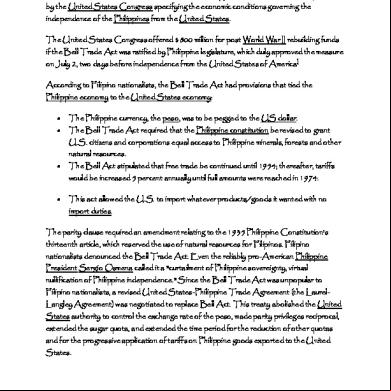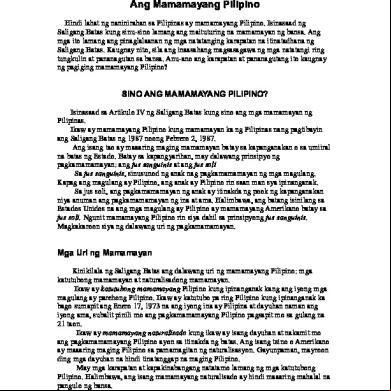Decision Making Under Uncertainty - Final 5t4i2i
This document was ed by and they confirmed that they have the permission to share it. If you are author or own the copyright of this book, please report to us by using this report form. Report 3i3n4
Overview 26281t
& View Decision Making Under Uncertainty - Final as PDF for free.
More details 6y5l6z
- Words: 864
- Pages: 21
STEPS TO GOOD DECISION-MAKING 1. Define problem and influencing factor. 2. Establish decision criteria. 3. Select decision making tool (model)
4. Identify and Evaluate alternatives using decision-making tool (model). 5. Select best alternative.
6. Implement decision. 7. Evaluate outcome.
Decision Making Under Uncertainty The outcome of a decision alternative is not known, and even its probability is not known. Parameters are estimated with certainty. Outcome – known Termed as DETERMINISTIC ANALYSIS Few criteria (approaches) are available for the decision makers to select according their preferences.
SOURCES OF UNCERTAINTIES DEMAND STRUCTURE
COMPETITORS
EXTERNALITIES
UNCERTAINTY
INTERNAL FORCES
SUPPLY STRUCTURE
TIME
METHODS: Decision-Making Under UNCERTAINTY 1.
Maximax Criterion
2.
Maximin Criterion
3.
Hurwicz alpha Criterion (Rationality or Realism)
4.
Laplace Criterion (Equally Likelihood)
5.
Minimax Criterion
CRITERION 1: MAXIMAX (Optimistic) • An adventurous and aggressive decision maker may choose to act that would result in the maximum payoff possible. Step 1. Pick maximum payoff of each alternative.
Step 2. Pick the maximum of those maximums in Step 1; its corresponding alternative is the decision. This is viewed as an optimistic approach, “Best of best”
CRITERION 1: MAXIMAX Maximizes the maximum payoff “Best of Best” State of Nature or Outcomes
Payoff Table: Alternatives
ECONOMY Growing
Stable
Declining
Bonds
41
46
5
Stocks
72
29
-12
72
Mutual Funds
54
50
-8
54
Best 46
Decision Alternatives *Payoffs in PROFIT
CRITERION 2: MAXIMIN (Pessimistic) • This is called Waldian Criterion. This criterion of decision making stands for choice between alternative courses of action assuming pessimistic view of nature. Step 1. Pick minimum payoff of each alternative. Step 2. Pick the maximum of those minimums in Step 1; its corresponding alternative is the decision. This is viewed as an pessimistic approach, “Best of the worst”
CRITERION 2: MAXIMIN Maximizes the minimum payoff “Best of Worst” Payoff Table: ECONOMY Alternatives
GROWING
STABLE
DECLINING
Bonds
41
46
5
Stocks
72
29
-12
-12
Mutual Funds
54
50
-8
-8
Worst 5
*Payoff is in PROFIT
CRITERION 3: HURWICZ (Realism) • This method is the combination of Maximum and Minimax criterion. Also known as criterion of rationality. This is neither too optimistic or too pessimistic. Step 1. Calculate Hurwicz value for each alternative. Step 2. Pick the alternative of largest Hurwicz value as the decision.
CRITERION 3: HURWICZ (Realism) Choose the best weighted average payoff based on a 𝛼coefficient Close to of1 realism = OPTIMISM 𝛼, 0 ≤ 𝛼 ≤ 1
𝛼 Close to 0 = PESSIMISM Alternatives
GROWING
STABLE
DECLINING
Bonds
41
46
5
Stocks
72
29
-12
Mutual Funds
54
50
-8
𝛼 (best payoff)
+
(1- 𝛼) (worst payoff)
CRITERION 3: HURWICZ (Realism) 𝛼 = 0.3
1- 𝛼 = 0.7
Alternatives GROWING
Bonds
41
STABLE
DECLINING
Weighted Average
46
5
.3(46) + .7(5) = 17.3
BEST
Stocks
72
29
BEST
Mutual Funds
𝛼 (best payoff)
54 BEST
+
WORST
-12 WORST
50
-8 WORST
(1- 𝛼) (worst payoff)
.3(72) + .7(-12) = 13.2 .3(54) + .7(-8) = 10.6
CRITERION 4: Equally Likely • The decision maker makes a simple assumption that each state of nature is equally likely to occur and compute average payoff for each. Choose decision with the average payoff. • Also known as LAPLACE Criterion.
Step 1. Calculate the average payoff of each alternative. Step 2. The alternative with the highest average is the decision.
CRITERION 4: Equally Likely (LAPLACE) Maximizes the average payoff “Best of Average” Payoff Table:
ECONOMY
Alternatives GROWING
Bonds
41
STABLE 46
DECLINING
Average Payoff
5
Stocks
72
29
-12
Mutual Funds
54
50
-8
=
Payoff1 + Payoff2 + Payoff3 3
*Payoff is in PROFIT
CRITERION 4: Equally Likely (LAPLACE) Maximizes the average payoff “Best of Average” ECONOMY GROWING
STABLE
DECLINING
Average
Bonds
41
46
5
(41+46+5) /3 = 30.7
Stocks
72
29
-12
(72+29-12)/3 = 29.7
Mutual Funds
54
50
-8
(54+45-8) /3 = 32
Alternatives
CRITERION 5: Minimax Regret • Application of Minimax criterion requires a table of losses or table of regret instead of gains. • Regret = Opportunity Cost = Opportunity Loss
Step 1. Construct a “regret table” Step 2. Pick a maximum regret of each row in regret table.
Step 3. Pick minimum of those maximums in Step 2, its corresponding alternative is the decision.
CRITERION 5: Regret Approach Regret Table: Alternatives
ECONOMY GROWING
STABLE
DECLINING
Bonds
50
55
5
Stocks
80
40
-18
Mutual Funds
63
45
-10
Regret = Opportunity Loss *Payoff in PROFIT
CRITERION 5: Regret Approach Regret Table: Alternatives
ECONOMY GROWING
STABLE
DECLINING
Bonds
50
55
5
Stocks
80
40
-18
Mutual Funds
63
45
-10
Regret = Best of Payoff – Payoff Received *Payoff in PROFIT
CRITERION 5: Regret Approach Regret Table:
ECONOMY GROWING
STABLE
80 – 50 = 30
55 – 55 = 0
50
55
80 – 80 = 0
55 – 40 = 15
80
40
80 – 63 = 17
55 – 45 = 10
63
45
DECLINING
Alternatives
Bonds Stocks Mutual Funds
5–5=0
5 5 – (-18) = 23
-18 5 – (-10) = 15
-10
CRITERION 5: Regret Approach
Regret Table Alternatives
ECONOMY
GROWING
STABLE
DECLINING
Maximum
Bonds
50
55
5
30
Stocks
80
40
-18
23
Mutual Funds
63
45
-10
17
*Payoff in PROFIT
4. Identify and Evaluate alternatives using decision-making tool (model). 5. Select best alternative.
6. Implement decision. 7. Evaluate outcome.
Decision Making Under Uncertainty The outcome of a decision alternative is not known, and even its probability is not known. Parameters are estimated with certainty. Outcome – known Termed as DETERMINISTIC ANALYSIS Few criteria (approaches) are available for the decision makers to select according their preferences.
SOURCES OF UNCERTAINTIES DEMAND STRUCTURE
COMPETITORS
EXTERNALITIES
UNCERTAINTY
INTERNAL FORCES
SUPPLY STRUCTURE
TIME
METHODS: Decision-Making Under UNCERTAINTY 1.
Maximax Criterion
2.
Maximin Criterion
3.
Hurwicz alpha Criterion (Rationality or Realism)
4.
Laplace Criterion (Equally Likelihood)
5.
Minimax Criterion
CRITERION 1: MAXIMAX (Optimistic) • An adventurous and aggressive decision maker may choose to act that would result in the maximum payoff possible. Step 1. Pick maximum payoff of each alternative.
Step 2. Pick the maximum of those maximums in Step 1; its corresponding alternative is the decision. This is viewed as an optimistic approach, “Best of best”
CRITERION 1: MAXIMAX Maximizes the maximum payoff “Best of Best” State of Nature or Outcomes
Payoff Table: Alternatives
ECONOMY Growing
Stable
Declining
Bonds
41
46
5
Stocks
72
29
-12
72
Mutual Funds
54
50
-8
54
Best 46
Decision Alternatives *Payoffs in PROFIT
CRITERION 2: MAXIMIN (Pessimistic) • This is called Waldian Criterion. This criterion of decision making stands for choice between alternative courses of action assuming pessimistic view of nature. Step 1. Pick minimum payoff of each alternative. Step 2. Pick the maximum of those minimums in Step 1; its corresponding alternative is the decision. This is viewed as an pessimistic approach, “Best of the worst”
CRITERION 2: MAXIMIN Maximizes the minimum payoff “Best of Worst” Payoff Table: ECONOMY Alternatives
GROWING
STABLE
DECLINING
Bonds
41
46
5
Stocks
72
29
-12
-12
Mutual Funds
54
50
-8
-8
Worst 5
*Payoff is in PROFIT
CRITERION 3: HURWICZ (Realism) • This method is the combination of Maximum and Minimax criterion. Also known as criterion of rationality. This is neither too optimistic or too pessimistic. Step 1. Calculate Hurwicz value for each alternative. Step 2. Pick the alternative of largest Hurwicz value as the decision.
CRITERION 3: HURWICZ (Realism) Choose the best weighted average payoff based on a 𝛼coefficient Close to of1 realism = OPTIMISM 𝛼, 0 ≤ 𝛼 ≤ 1
𝛼 Close to 0 = PESSIMISM Alternatives
GROWING
STABLE
DECLINING
Bonds
41
46
5
Stocks
72
29
-12
Mutual Funds
54
50
-8
𝛼 (best payoff)
+
(1- 𝛼) (worst payoff)
CRITERION 3: HURWICZ (Realism) 𝛼 = 0.3
1- 𝛼 = 0.7
Alternatives GROWING
Bonds
41
STABLE
DECLINING
Weighted Average
46
5
.3(46) + .7(5) = 17.3
BEST
Stocks
72
29
BEST
Mutual Funds
𝛼 (best payoff)
54 BEST
+
WORST
-12 WORST
50
-8 WORST
(1- 𝛼) (worst payoff)
.3(72) + .7(-12) = 13.2 .3(54) + .7(-8) = 10.6
CRITERION 4: Equally Likely • The decision maker makes a simple assumption that each state of nature is equally likely to occur and compute average payoff for each. Choose decision with the average payoff. • Also known as LAPLACE Criterion.
Step 1. Calculate the average payoff of each alternative. Step 2. The alternative with the highest average is the decision.
CRITERION 4: Equally Likely (LAPLACE) Maximizes the average payoff “Best of Average” Payoff Table:
ECONOMY
Alternatives GROWING
Bonds
41
STABLE 46
DECLINING
Average Payoff
5
Stocks
72
29
-12
Mutual Funds
54
50
-8
=
Payoff1 + Payoff2 + Payoff3 3
*Payoff is in PROFIT
CRITERION 4: Equally Likely (LAPLACE) Maximizes the average payoff “Best of Average” ECONOMY GROWING
STABLE
DECLINING
Average
Bonds
41
46
5
(41+46+5) /3 = 30.7
Stocks
72
29
-12
(72+29-12)/3 = 29.7
Mutual Funds
54
50
-8
(54+45-8) /3 = 32
Alternatives
CRITERION 5: Minimax Regret • Application of Minimax criterion requires a table of losses or table of regret instead of gains. • Regret = Opportunity Cost = Opportunity Loss
Step 1. Construct a “regret table” Step 2. Pick a maximum regret of each row in regret table.
Step 3. Pick minimum of those maximums in Step 2, its corresponding alternative is the decision.
CRITERION 5: Regret Approach Regret Table: Alternatives
ECONOMY GROWING
STABLE
DECLINING
Bonds
50
55
5
Stocks
80
40
-18
Mutual Funds
63
45
-10
Regret = Opportunity Loss *Payoff in PROFIT
CRITERION 5: Regret Approach Regret Table: Alternatives
ECONOMY GROWING
STABLE
DECLINING
Bonds
50
55
5
Stocks
80
40
-18
Mutual Funds
63
45
-10
Regret = Best of Payoff – Payoff Received *Payoff in PROFIT
CRITERION 5: Regret Approach Regret Table:
ECONOMY GROWING
STABLE
80 – 50 = 30
55 – 55 = 0
50
55
80 – 80 = 0
55 – 40 = 15
80
40
80 – 63 = 17
55 – 45 = 10
63
45
DECLINING
Alternatives
Bonds Stocks Mutual Funds
5–5=0
5 5 – (-18) = 23
-18 5 – (-10) = 15
-10
CRITERION 5: Regret Approach
Regret Table Alternatives
ECONOMY
GROWING
STABLE
DECLINING
Maximum
Bonds
50
55
5
30
Stocks
80
40
-18
23
Mutual Funds
63
45
-10
17
*Payoff in PROFIT











